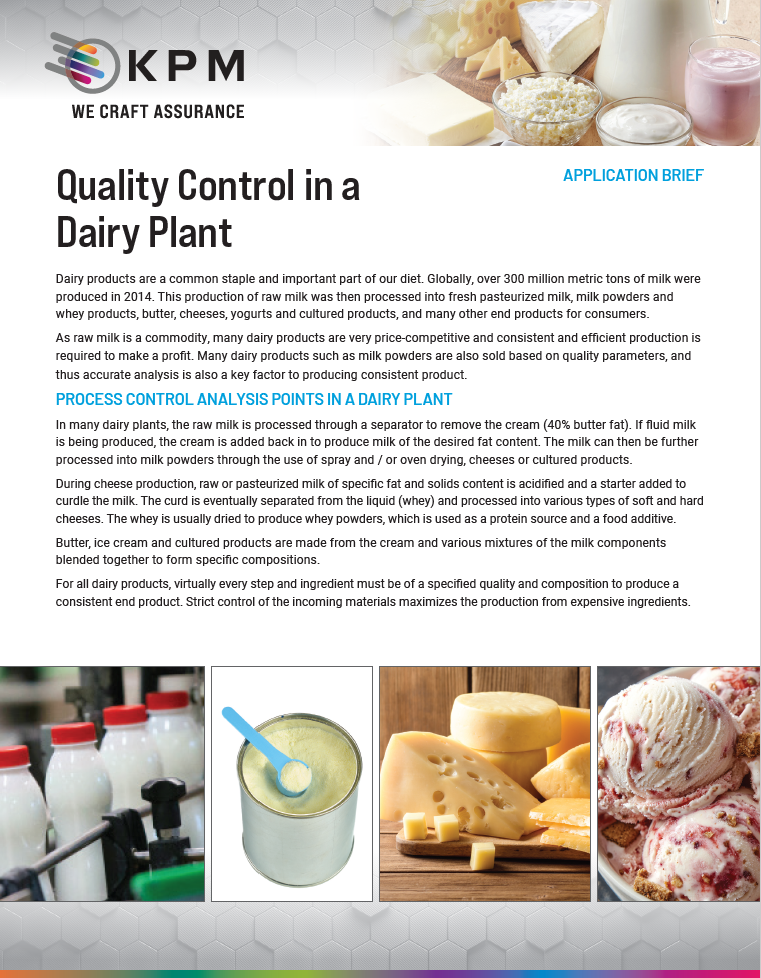NIR for Yogurt Quality Analysis: Enabling Precise Quality Control for a Major Dairy Producer

In this success story, we discuss how a large dairy foods producer, an existing customer who was using the SpectraStar™ XT NIR technology to analyze dairy powder quality, worked with KPM Analytics to help devise a new application to measure protein, fat, and total sugar in yogurt.
Learn more about this and about how NIR analysis helps dairy foods producers verify quality throughout the production process, and in turn, improve the consistency of final products.
For decades, near-infrared spectroscopy (NIR) analysis has been used to verify the quality of dairy foods, including dairy powders, cheese, ice cream mixes, and more. Over the years, NIR calibrations have been developed to measure dairy products for moisture, protein, fat, and other critical parameters. These calibrations have become more repeatable over time thanks to continued research and application customization, all for the purpose of helping dairy foods producers verify quality throughout the production process, and in turn, improve the consistency of final products.

Cultured dairy products, including yogurt, are a growing segment of dairy foods that offer several health benefits and varieties to satisfy the tastes of most consumers. All cultured dairy products are produced by introducing live active cultures to milk, which in turn creates a fermentation process.
Yogurt development involves incubating the product for a period at a controlled temperature as the fermentation process takes place. After this period, the product is packaged and refrigerated.
However, maintaining the production of consistent, high-quality yogurt is complicated by the natural variations found both in the raw ingredients and the cultures used to create the products. With the help of at-line NIR analysis and calibrations, yogurt manufacturers can analyze and control vital quality parameters and reduce instances of batch inconsistencies.
A Novel, Customized NIR Calibration for a Superior Yogurt Variety
Every NIR calibration is a mathematical correlation between raw NIR data taken from a sample compared with a chemical constituent or property of interest. The samples used to create a calibration should be representative of the future unknown samples to be measured in all areas of potential variability, including constituent range(s), origin, seasonal variation, and others.
Collecting the right samples is often the most difficult step to creating an NIR calibration. A minimum number of samples (~50 for most products) is required to obtain a provisional calibration, but more robust calibrations can require hundreds or thousands of samples depending on the product type. Also, not all samples should be “ideal” in terms of parameter quality – it is worthwhile to introduce out-of-specification or poor quality samples in order to establish a more robust final calibration.

Recently, a large dairy foods producer – who already implemented at-line SpectraStar™ XT NIR technology to analyze dairy powder quality – reached out to KPM Analytics to help devise a new application to measure protein, fat, and total sugar in yogurt. Rapid and accurate analysis during production could help ensure proper manufacturing conditions, leading to improved product quality and reduced waste. Early detection of raw ingredient or manufacturing issues provides the production manager with time to fix the issue or abort costly and time-consuming production of inferior products.
As each yogurt manufacturer has proprietary ingredients, recipes and processes, this particular user needed a customized solution for a specific yogurt variety, which could be then implemented across multiple sites around the country. This is where decades of experience in developing specialized calibrations for unique applications became crucial for solving this customer’s challenge.
A team of KPM Analytics applications specialists worked directly with the quality control manager for this dairy enterprise. As they had already worked together for the dairy powder application, they were ready with an instrument to collect data and a protocol to share calibration data with the team.
The first experiments with the SpectraStar XT-R system focused on low-temperature yogurt, and an initial calibration of approximately 70 samples showed very good accuracy and repeatability that was very similar to the reference lab performance. A further validation of 50 samples at the customer’s site confirmed the performance and the customer was satisfied with the repeatability and accuracy of the results.



